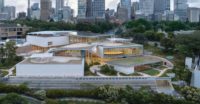In the middle of last month, a group of 60 architects and other allied professionals from across the country gathered near Washington, D.C. to reimagine the shape of design practice.
The aim of the two-day symposium, held in Arlington, Virginia, and dubbed the “Practice Innovation Lab,” was to develop new ideas for raising architects’ value, said Evelyn Lee, a corporate managing director at commercial real-estate consultant, Savills Studley and the chair of the Young Architects Forum (YAF). The group, which organized the lab, is part of the American Institute of Architects (AIA) and is open to architects licensed 10 years or fewer. “If all architects do is offer our traditional services, the profession will become extinct,” she said.
The event was not limited to YAF members. In order to take advantage of a diverse set of interests, unlicensed architectural designers, architects working outside traditional practice, and non-AIA members were also eligible to apply, explained Milan Jordan, manager of the AIA’s Center for Emerging Professionals. A jury selected the participants from a pool of 200 candidates who submitted a written or video-taped “manifesto” describing where the profession should be in 2030, as well as a resume and a portfolio. Academics, developers, sole practitioners, and employees from large, national firms were in attendance.
The agenda included presentation from designers who are using their skills in diverse ways. Among them were James Patten, a visual artist who deploys digital technology to create interactive objects and environments; Susan Chin, executive director of the New York-based public interest design nonprofit, the Design Trust for Public Space; and Andrea Sreshta, co-founder of LuminAID, a company that has developed a portable solar-powered lighting suitable for both disaster response and outdoor recreation. These speakers provided examples of alternative modes of practice as well as inspiration and encouragement. Susan Chin, for instance, offered advice on how to engage the public and create consensus among stakeholders: “The leadership role you all have is critical,” she said.
The lab’s central activity was a series of breakout sessions where participants, in groups of six, developed a proposal for a new architectural practice. Here they decided their firm’s missions, what services it would offer, and what its profit model would be. The ambition “was to develop tangible tools that can be brought forward,” explained the YAF regional director for Northern California and event participant, Ian Merker, who works at Rainforth Grau Architects in Sacramento.
As the culmination of the symposium, the ten teams presented their hypothetical practices in five-minute elevator pitches. There were many recurring themes, including decentralized firms organized as collectives, firms that would take an equity stake in projects, and firms that would harness operational data from their completed buildings. Almost all aspired to advancing community interests and protecting the environment. The winning team, chosen by a vote of all the participants, was a socially-minded network of affiliated practitioners that would share resources such as technology and support services. Its tag line was “act big, stay small, and do good.”
Now that the symposium has ended, the YAF plans to roll out similar events at the state and local level. Jordan invites those that are interested in continuing the discussion about the future of the profession to keep an eye out for a Practice Innovation Lab session at the 2018 national AIA convention, to be held in June in New York City.








Post a comment to this article
Report Abusive Comment